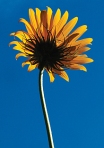I just knew pinning a flower on my first needle-felted hat attempt would improve it immensely. A little embellishment goes a long way. Not bad for a first attempt, right? Ahem. Don’t look too closely.
 And a few words to the person who wrote the instructions on how to use the foam hat form—you really shouldn’t have put the sentence “Stabbing too deeply will pull chunks of foam out and mess up your project!” in the middle of the instruction sheet. It would have been much more helpful to have that as step #1 in the process. I felted so hard to the foam that I think Nancy pulled a shoulder muscle trying to wrestle the finished hat off the foam form. It resembled a rainbow brite-colored cat hairball at first glance. After a little prodding, pulling and cajoling, the hat began to take shape, although I’m still not sure I would wear it in public (so I offer my sincerest apologies to the sheep that gave up its coat for this project—I did not do your offering justice, I’m afraid). It is a first attempt, remember, so temper your judgment. Stephanie, however, makes it look like a boutique hat, so I’m not too terribly disappointed with my freshman try at needle felting a hat. Thanks for modeling for me, Stephanie!
And a few words to the person who wrote the instructions on how to use the foam hat form—you really shouldn’t have put the sentence “Stabbing too deeply will pull chunks of foam out and mess up your project!” in the middle of the instruction sheet. It would have been much more helpful to have that as step #1 in the process. I felted so hard to the foam that I think Nancy pulled a shoulder muscle trying to wrestle the finished hat off the foam form. It resembled a rainbow brite-colored cat hairball at first glance. After a little prodding, pulling and cajoling, the hat began to take shape, although I’m still not sure I would wear it in public (so I offer my sincerest apologies to the sheep that gave up its coat for this project—I did not do your offering justice, I’m afraid). It is a first attempt, remember, so temper your judgment. Stephanie, however, makes it look like a boutique hat, so I’m not too terribly disappointed with my freshman try at needle felting a hat. Thanks for modeling for me, Stephanie!
RECYCLED SWEATER FLOWER
The flower pin was made by Leslie of Sweaterheads, in Astoria, Oregon. I met Leslie at the Portland Saturday Market (arts and crafts heaven!) two years ago and she explained how she makes these flowers with recycled wool sweaters. Check out this link here that details other projects you can create with wool sweaters or click here to read Diane Gilleland’s article on how to felt sweaters. You can crochet or knit projects such as hats and then felt them yourself, but recycling with sweaters from thrift stores (or your own closet) is faster and cheaper—not to mention it breathes new life into discarded stuff! Always a good thing. Check out the step-by-step process of washing machine felting on ehow.com.
EARLIER THAT DAY—FIBER UTOPIA
On Saturday, Michael and I drove up to the Howard Country Fairgrounds in Maryland to the Maryland Sheep & Wool Festival to meet his sister Nancy, her friend Marie and Marie’s niece Stephanie. All three women are avid knitters and yarn fanatics. By fanatic, I mean Nancy and Marie start the process from the sheep/rabbit/alpaca up! They both raise fiber-bearing animals and shear, spin and weave their results. We joined Nancy two years ago at the festival and came home with roving (wool that has been washed, combed and carded), a spinning wheel, needle felting equipment, and a ton of enthusiasm for all things wool. The only thing we didn’t bring home were sheep. Not that it hadn’t crossed our minds, mind you. Where there’s a will, there’s a…sheep. But the townhouse homeowner association might frown upon that…even if Michael is on the Board. On this trip, Nancy brought us almost-black wool cleaned and ready to spin (or felt) from the progeny of a ram we “invested” in for her hobby farm endeavors. She also set up our spinning wheel (again) so we could actually use it. Thanks, Nancy! SIDEBAR: Nancy bought some funny t-shirts for her sons. The shirts had an illustration of a ram with the slogan, “I think therefore I ram.”

I’M JUST SAYIN’…
It may just be me, but I think there’s something inherently wrong with selling lamb kabobs at a fair within smelling distance of the live lambs. As my baby sister would say, it’s just not right. But I digress.
 WOMENFOLK
WOMENFOLK
After we returned home, we gathered ’round the fire coffee table and drank champagne Diet Coke with Ned Michael while playing delightful parlor games crafting. I felt like I had stepped into Louisa May Alcott’s Little Women (I’m a cross between Jo and Amy, I’ve determined). And there just happened to be exactly four of us. Pretty cool. If this is what they do in the obviously-crafty state of Ohio, maybe we should consider moving there. I could get into this creative group dynamic! No tv, no music, no other distraction. Just the (overzealous) tap, tap, tap of my scary felting needle and the clicking of knitting needles from the sock and shawl creators. Pictured above: Little Women Nancy, Stephanie and Marie. A word of warning: all knitters and crocheters can multi-task while doing their craft. You really can’t shouldn’t multi-task when you’re needle-felting. If you do, you will end up with one sharp barb (or 3, 6, or 12 of them) in your finger (much more painful than a sewing needle prick, trust me). Sadly, this supreme multi-tasker speaks from experience. It is a pay-close-attention-to-what-you’re-doing endeavor. Those barbs are sharp—have a box of bandaids at the ready!
 Nancy and I shared needle felting duties on this hat. Marie was knitting a shawl and Stephanie was creating an elaborately-patterned pair of socks. I asked Stephanie how long a pair of socks takes to make and she said about a week. We assessed that this would be at least a 40-hour work week. If we assumed she would be paid at least the current minimum wage ($6.55 per hour), she could bill $262.00 for her time. Adding what I’m assuming could be anywhere from $10-20 for the yarn (just a wide-ranging guess, some yarn skeins run $25+ each, depending on the fiber content), she would have to sell that pair of socks for almost $300 to cover time and materials. She just graduated in December with a geology degree and is gainfully employed in Harrisburg, PA. I advised her against quitting her day job. Making socks is obviously a labor of love and not a pathway to wealth. So if you ever see handmade socks priced at $20+ per pair, don’t tsk tsk over the price!
Nancy and I shared needle felting duties on this hat. Marie was knitting a shawl and Stephanie was creating an elaborately-patterned pair of socks. I asked Stephanie how long a pair of socks takes to make and she said about a week. We assessed that this would be at least a 40-hour work week. If we assumed she would be paid at least the current minimum wage ($6.55 per hour), she could bill $262.00 for her time. Adding what I’m assuming could be anywhere from $10-20 for the yarn (just a wide-ranging guess, some yarn skeins run $25+ each, depending on the fiber content), she would have to sell that pair of socks for almost $300 to cover time and materials. She just graduated in December with a geology degree and is gainfully employed in Harrisburg, PA. I advised her against quitting her day job. Making socks is obviously a labor of love and not a pathway to wealth. So if you ever see handmade socks priced at $20+ per pair, don’t tsk tsk over the price!
 WHAT IS NEEDLE FELTING? FUNNY YOU SHOULD ASK!
WHAT IS NEEDLE FELTING? FUNNY YOU SHOULD ASK!
Needle felting is felting without water (dry felting). You use special barbed felting needles to push the top layer of wool “roving” into subsequent layers. Wool roving is wool that has been washed, combed, carded (and sometimes dyed) into a thick rope to be spun into yarn. Roving can also be made from cotton, silk and other fibers. When wool roving is prepared, but not twisted, it is known as a “sliver.”
I’m not entirely new to the needle felting process. I did make some rather nice free-form flowers (including a sunflower complete with a hovering bee!) for my crocheted hats after attending the festival the first time. I also created a series of miniature 3-D fruits for one hat, a tribute to Carmen Miranda. Many of the videos on youtube.com utilize cookie cutters and molds as guides; I created mine in a free-form fashion. You can buy needle felting applique molds like these here. My freshman fruits and flowers were created with either a single needle or three-needle implement, rather than the menacing 12-needled one I used on the hat above. I own the pattern shown at left, but have yet to make one of these more detailed flowers. Aren’t they stunning? You can buy the pattern on Indygo Junction’s website here. You’ll find kits, patterns, roving, pre-felted felt squares, felt appliques, ready-to-embellish purse “blanks” and finished purses and flowers on this link here. Below is a flower pin I bought at the festival. I’m inspired to create some variations of my own. It measures about 4-5 inches across and was needle felted with four colors of wool roving.
INTRODUCTION TO MACHINE FELTING
If you’re interested in needle felting but don’t want to do it entirely by hand, check out the needle felt or needle punch machines. The machines use barbed needles to mesh decorative fibers and fabrics together onto a base fabric in an applique fashion. I bought a demo clearance model last year and have played with it a little. Now I’m inspired to get it out of the hall closet and actually create something to crow about! There are fantastic videos on needle punching (with a specific machine by Janome) here and here. Brother makes reasonably-priced machines and has some great techniques on their website here. Machine needle felting doesn’t require a bobbin, thread, or previous sewing experience, and the creative possibilities are infinite.
MUST-HAVE SUPPLIES
To needle felt flowers, jewelry or 3-d characters (or a questionable hat like mine, for that matter) by hand, you’ll need some of the supplies below. The website I’m linking you to isn’t the only source of these materials—you can also find them at your local craft store on other online vendors.
Wool roving:
http://www.thefeltedewe.com/rovings.html
http://www.ericas.com/yarn/needlefelt2.htm
Felting needles and holders:
http://hookedonfelt.com/tools.htm#a2
http://www.thefeltedewe.com/supplies.html
Molds for flowers, leaves and other shapes (if you need more structure and fear the free-form process!):
http://www.thefeltedewe.com/Clover.html
Needle felt hat forms (from Hooked on Felt, the originator of this product that I used for my hat):
http://www.etsy.com/view_listing.php?listing_id=20528185
________________________________________________________________________
STILL CURIOUS? WATCH THESE:
Needle felting on felt scraps (what gorgeous flowers!):
http://gfwsheep.com/feltflower/feltflower.html
Needle felting a heart lapel pin: http://www.youtube.com/watch?v=2kDb7Tumvhs
Needle felting directly onto a purse: http://www.youtube.com/watch?v=f_NmQZx0Slo
Beautiful samples of felted flowers for sale on etsy.com and kaboodle.com.
Machine needle felting demo here (watch the 40-second live demo at the bottom of the site): http://www.fiberella.com/html/techniques.html
Needle felting basics:
http://thesilverpenny.homestead.com/freeprojectneedlefelting.html
© Cindy Dyer. All rights reserved.













































Recent Comments